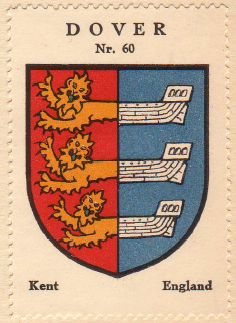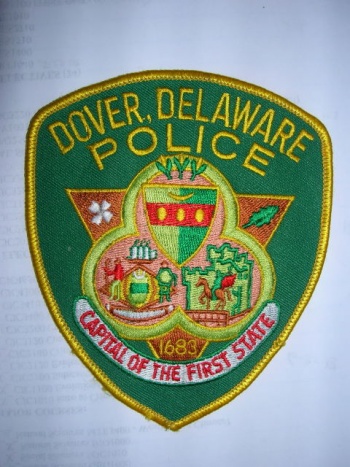Dover (England)
| Heraldry of the World |
| British heraldry portal Civic heraldry of the United Kingdom |
|
DOVER
District Council
Additions: 1974 Deal (Borough), Dover (Borough), Dover RDC, Eastry RDC (partly), Sandwich (Borough)
Official blazon
Arms : Per pale Gules and Azure on a Fess wavy counterchanged between two demi-Lions passant guardant each conjoined to the Hulk of a Ship a like Hulk conjoined to a demi-Lion counter passant all Gold.
Crest : On a Wreath Or and Gules a demi Horse Argent supporting a Tower Gold.
Supporters : On either side a Sea Horse Argent gorged with a Naval Crown Or and grasping in the fin of the interior foot a Sword bendwise Argent pommel hilt and quillons Gold.
Origin/meaning
The arms were officially granted on October 19, 1987.
The District of Dover contains three of the Cinque Ports, Deal, Dover and Sandwich. It is appropriate that the arms should be based on the Cinque Ports shield, divided into three by waves.
The crest has the white horse of Kent, made distinctive by a tower taken from Deal's crest.
The supporters are again the white horse of Kent, made into seahorses and with the distinctive addition of a naval crown and sword to signify the historic importance of Dover to the defence of England.
Borough
Dover was already an important harbour city in medieval times, and one of the main cities of the Cinque Ports.
The oldest known seal of Dover dates from around 1180 and shows simply a ship. It was used on a (lost) charter in the archives of the Abbey of St. Omer in France, but a copy of the document and seal was made.
| The oldest seal of Dover |
A second seal dates from 1305 and also shows a ship, now in more detail, and with the banner of the Cinque Ports on the stern. The seal indicates that the city is a major harbour.
| The second seal of Dover |
The reverse of the seal shows the story of St. Martin of Tours, cutting his cloak for a beggar in front of the city gate of Amiens. This was probably taken from the 13th century seal of Dover Priory, which showed the Saint, with in front a small shield with a cross and four leopard's heads. The composition is surrounded by a circle of six lions passant/counter-passant.
The seal has also been recorded by the College of Arms in the Visitations of 1574.
The Borough did not have official arms, but adopted in 1861 a combination of three shields as can be seen below. These are the arms of the Cinque P{orts and the obverse and reverse of the old seal, without the inscriptions and lions. It replaced older arms with a cross and four leopard's heads, which probably were the true arms of Dover Priory, used erroneously by the town.
The new devise with the three shields was designed by the Somerset Herald of the College of Arms.
Even though the devise was duly recorded, different sources showed different arms for the city, including the cross with four leopard's heads, the image of St. Martin and the image of St. Martin with a bordure of lions (see below from Fox-Davies, 1915).
| The arms by Fox-Davies (1915) |
Until the mergers in 1974 the city still used the old seal or a more modern copy thereof.
Use on collector's items:
| The arms on a Wills's cigarette card, 1906 |
The arms as used on a Faulkner postcard +/- 1905 |
| The arms on a Thomson and Porteous cigarette card, 1906 |
The arms on crested china, +/- 1910 |
On two occasions the arms of Dover Priory were still listed as the arms for Dover city:
| The arms as used on a JaJa postcard +/- 1905 |
The arms as used on a Faulkner postcard +/- 1905 |
Only once the arms of the Cinque Ports or the image of St. Martin were used:
| The arms in the Coffee Hag albums +/- 1935 |
The arms in the Reddings tea card 1933 |
Use in the city:
| The arms on the Marine Parade (Source) |
The arms on a Freedom of Dover box (Source) |
Dover, Delaware, USA uses a devise based on the arms of Dover:
| The arms on a police badge (Source) |
Contact and Support
Partners:
Your logo here ?
Contact us
© since 1995, Heraldry of the World, Ralf Hartemink 
Index of the site
Literature: Information provided by Laurence Jones (laurencejones@eircom.net); Williams, 1971


























